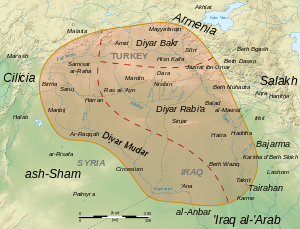Sinjar
| Sinjar Kurdish: شنگار/شنگال /Şengar/Şingal | |
|---|---|
|
Yezidi Temple on Mount Sinjar, 2004. | |
 Sinjar Location within Iraq | |
| Coordinates: 36°19′21″N 41°51′51″E / 36.32250°N 41.86417°ECoordinates: 36°19′21″N 41°51′51″E / 36.32250°N 41.86417°E | |
| Country |
|
| Governorate | Nineveh Governorate |
| Government | |
| • Mayor | Mahma Xelil[1] |
| Elevation | 522 m (1,713 ft) |
| Population (2013) | |
| • Total | 88,023 |
| Time zone | GMT (UTC+3) |
Sinjar, also known as Shingal[2] (Kurdish: Şengal/Şingal/Şingar/شنگار/ شنگال[3][4][5][6], Ancient: Singara) is a town in Shingal District, Nineveh Province, Iraq near Mount Shingal. The town is inhabited mainly by Yazidis, with a Muslim Kurdish minority. Its population in 2013 was estimated at 88,023.[7]
The important Chermera temple (meaning 40 Men) is found on the highest peak of the Sinjar Mountains.
History

In the 2nd century A.D., Sinjar became a military base and part of the Roman limes, and it remained part of the Roman Empire until it was sacked by the Sassanids in 360 A.D. At the beginning of 6th century A.D., it was inhabited by a tribe called Qadišaiē (Kαδίσηυοι) who were of Kurdish or Arab descent. It was conquered by the muslim Arabs led by Iyad ibn Ganan[8].
In 2007, several explosions set off by al-Qaeda in Iraq killed hundreds of Yazidis in Shingal.[9]
Northern Iraq Offensive (2014)
In the course of their second Northern Iraq offensive in August 2014, ISIS conquered large areas of Nineveh province. Following the defeat against the Kurdish Peshmerga they seized the city of Shingal on 3 August. During the following days, IS militants perpetrated the Sinjar massacre, killing 2,000 Yazidi men and taking Yazidi women into slavery, leading to a mass exodus of Yazidi residents. According to a UN report, 5,000 Yazidi civilians were killed during ISIL's August offensive.[10]
On the night of 20 December 2014, in the course of a first offensive to retake it from Islamic State militants, Kurdish forces pushed into the city of Sinjar.[11] However, the Kurdish advance into the city was stalled, as they faced fierce resistance from the ISIL militants inside the southern half of the city.[12]
On 13 November 2015, a day after launching a major second offensive, Kurdish forces and Yazidi militias backed by US airstrikes, entered the city and fully regained its control from ISIS.[13] Following the recapture, in nearby hamlet of Solagh, east of Sinjar city, Kurdish forces found a mass grave with the remains of at least 78 Yazidi women from Kocho village believed to be executed by ISIL militants.[14][15]
Following the liberation of Sinjar, Yazidi groups engaged in revenge looting and burning targeting Sunni Muslims, as well as reprisal killings.[16][17]
See also
- Yazidi genocide
- Military intervention against ISIL
- American-led intervention in Iraq (2014–present)
- Kurdification
- Arabization
- Ezidkhan
- Assyrian homeland
References
- ↑ http://www.basnews.com/index.php/en/news/kurdistan/283611
- ↑ King, Diane E. (2013). Kurdistan on the Global Stage: Kinship, Land, and Community in Iraq. Rutgers University Press. p. 181. ISBN 9780813563541.
- ↑ "Pêşmergeyan Şingal rizgar kirin (Peshmerga liberated Sinjar (in Kurdish)". Avesta Kurd. 13 Nov 2015. Retrieved 13 Nov 2015.
- ↑ "ŞENGAL - Barzanî operasyonê dimeşîne (gav bi gav tên nûkirin)". Sputnik News. 12 Nov 2015. Retrieved 13 Nov 2015.
- ↑ "YAZIDIS i. GENERAL". Encyclopaedia Iranica. 20 July 2004. Retrieved 13 Nov 2015.
The Yazidis’ cultural practices are observably Kurdish, and almost all speak Kurmanji (Northern Kurdish), with the exception of the villages of Baʿšiqa and Baḥzānēin northern Iraq, where Arabic is spoken. Kurmanji is the language of almost all the orally transmitted religious traditions of the Yazidis.
- ↑ Abul Fazl-i-Ạllámí (1894), "Description of the Earth", The Áin I Akbarí, Vol. III, Translated by H.S. Jarrett, Calcutta: Baptist Mission Press for the Asiatic Society of Bengal, p. 25–27.
- ↑ "Iraq: largest cities and towns and statistics of their population". World Gazetteer.
- ↑ Alexander, Paul J. (1985). The Byzantine Apocalyptic Tradition. University of California Press. p. 27. ISBN 0520049985.
- ↑ Shefler, Gil (7 August 2014). "Islamic State accused of capturing Yazidi women and forcing them to convert, or else". Washington Post. Religion News Service. Retrieved 7 October 2014.
- ↑ "Isil carried out massacres and mass sexual enslavement of Yazidis, UN confirms". Daily Telegraph. 14 October 2014. Retrieved 27 October 2015.
- ↑ "Iraq's Kurds press offensive against Islamic State in Sinjar". DPA International. Retrieved 21 December 2014.
- ↑ "Iraqi Kurds Advance Against Islamic State in Sinjar". Wall Street Journal. Retrieved 21 December 2014.
- ↑ "Battle for Sinjar: IS-held town in Iraq 'liberated'". BBC News. 13 November 2015.
- ↑ Isabel Coles (14 November 2015). "Mass Yazidi grave discovered after Iraq's Sinjar taken from Islamic State". Reuters. Retrieved 14 November 2015.
- ↑ "Mass grave of ‘Yazidi women executed by ISIS’ found in Iraq". AFP. 14 November 2015. Retrieved 14 November 2015.
- ↑ "Yazidis burn Muslim homes in Iraq's Sinjar: witnesses". Yahoo News. 15 November 2015.
- ↑ "Yazidis Get Revenge On ISIS In Sinjar". The Daily Beast. 3 December 2015.